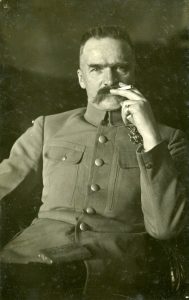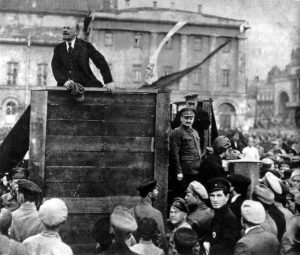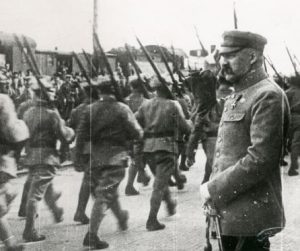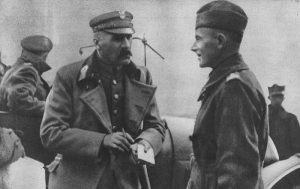 War was never declared between Poland and Bolshevik Russia although a clash between them over both the border and the fate of the territories which were part of the Polish-Lithuanian Commonwealth before the Partitions was inevitable. The rivalry focused mainly on Poland’s independence but also on the regions with ethnically mixed populations lying between Poland and Russia.
War was never declared between Poland and Bolshevik Russia although a clash between them over both the border and the fate of the territories which were part of the Polish-Lithuanian Commonwealth before the Partitions was inevitable. The rivalry focused mainly on Poland’s independence but also on the regions with ethnically mixed populations lying between Poland and Russia.
On 16 November 1918 the Red Army commenced operation Vistula by occupying Belarusian territory and part of Lithuania. At the turn of 1919 it drove the Polish samoobrona (self-defence) units out of the Minsk, Nowogródek and Vilnius regions and occupied Vilnius city. Once the German armies had retreated from the east the Polish forces undertook a counteroffensive.
The offensive in April 1919 under Józef Piłsudski’s command saw the Poles recapturing Vilnius and the surrounding region, then occupying a substantial part of Belarus up to the Daugava and Berezina rivers. Józef Piłsudski considered the impressive success of the Vilnius operation as “passing the test” to be Commander-in-Chief.
In the autumn of 1919 Piłsudski decided to limit military operations against the Bolsheviks for fear of facilitating victory by the White Russians in the ongoing civil war in Russia. Both the political activists and the military on the side of the Whites (opponents of Bolshevism) questioned Poland’s right to independence and its territorial reach in the east. The political goals pursued by Piłsudski included complete elimination of the threat from Russia. As a consequence the Commander-in-Chief sought potential allies among the nations living to the east of Poland.

The Polish-Soviet War entered its deciding phase in the spring of 1920. In April Piłsudski made a pact with the Ukrainian leader Ataman Symon Petlyura and at the head of the Polish and Ukrainian armies he launched a joint offensive with the goals of driving the Bolsheviks out of the Ukraine, liberating Kiev and establishing a sovereign Ukrainian state, an ally of Poland. This operation wrong-footed the Red Army’s planned strike in Belarus: following victory over the White Russians Bolshevik Russia had been assembling its forces in Belarus in readiness for spreading the flame of revolution to the West. After some initial successes (in May under the command of General Edward Rydz-Śmigły the Polish army occupied Kiev) the Red Army’s huge counteroffensive forced the Poles to withdraw first from Kiev and then from Belarus.
The threat of losing its recently regained independence loomed over Poland: the Bolshevik slogans claimed the victorious communist revolution would march on into Hungary, Germany and perhaps even further to the west “over the corpse of White Poland”. The Red Army forced their way into areas that were ethnically Polish. The very existence of an independent Polish Republic was under threat. In Białystok the communists appointed a puppet body the Provisional Polish Revolutionary Committee intended to be an embryonic Bolshevik government for Poland.
Poland’s position on the international stage was also changing for the worse. During the Spa Conference in July 1920 the British Prime Minister David Lloyd George pushed Poland into accepting the Curzon Line which moved Poland’s eastern border to follow the line of the rivers Niemen and Bug. The Lithuanians received Vilnius from the Bolsheviks in exchange for a peace agreement and permission for the Red Army to march through their country. A ruling of the Entente Powers’ Council of Ambassadors on 28 July 1920 gave Czechoslovakia the majority of the disputed territory in Cieszyn Silesia.

The Red Army was moving quickly towards Warsaw and also gained the upper hand on the southern front. The dramatic situation motivated ordinary Poles to offer their help. The ranks of the Volunteer Army swelled and donations poured into the coffers of the National Defence Fund. The Battle of Warsaw played out from 12 to 25 August. It was a clash that was to determine Poland’s fate and according to Lord Edgar d’Abernon, who in 1920 was a member of the Interallied Mission to Poland, it was the “The Eighteenth Decisive Battle of the World”.
The brilliantly executed strike from the river Wieprz which surprised the enemy gave the Poles a crucial victory in this war to defend their independence and to defend European ideas and values. This attack was the most important element of the operational plan prepared by Piłsudski which made use of information gathered by the Polish intelligence service intercepting radio communications.
Piłsudski carried out the functions of Commander-in-Chief and personally commanded the strike force making the manoeuvre. In the operational order dated 15 August 1920 he emphasised the following point,
‘I shall take direct control of the counter-attack.’

The Red Army was forced to retreat a long way and at certain points the retreat became a rout. The crowning achievements of the Polish counteroffensive were victory in the Battle of the Niemen River fought from 20 to 26 September and the operations in Volhynia and Podolia.
Both sides were drained by the war and so they agreed to call a truce on 12 October 1920 and began peace negotiations. The treaty signed in Riga on 18 March 1921 demarcated the eastern border of Poland. Unfortunately the price of peace and defence of Poland’s independence was Poland abandoning its Ukrainian and Belarusian allies and thereby acknowledging Bolshevik rule in parts of Belarus and Ukraine.
The Polish-Soviet War of 1919–1920 showcased the full extent of Józef Piłsudski’s leadership talent. He took advantage of positional and timing factors in masterly fashion in order to execute a manoeuvre that gave him the benefit of surprise. Piłsudski was rewarded for his role in the war and outstanding skill as a commander by the award of a Marshal’s baton. This took place after the military action had ended on 14 November 1920 and it was a fitting complement to the rank of First Marshal of Poland he had been awarded half a year earlier on 19 March.



